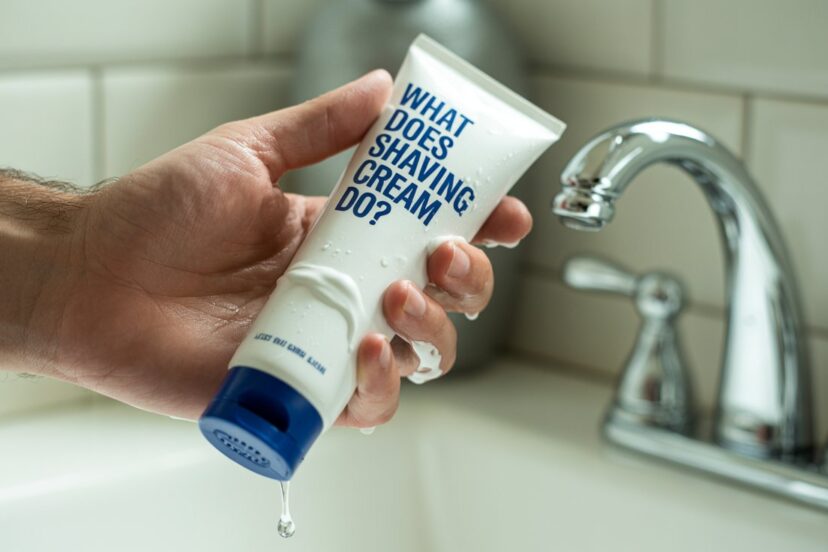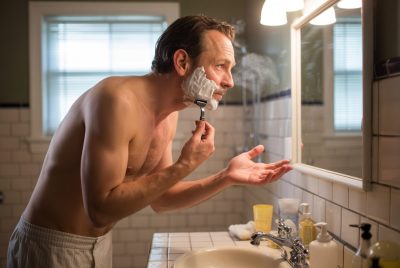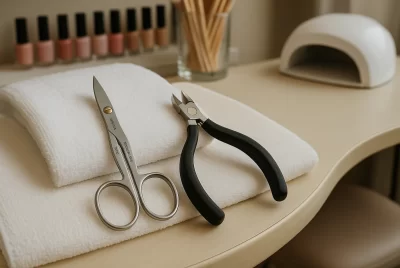What Shaving Cream Do: The Science Behind Better Shaves
Post Disclaimer
*We may earn a commission for purchases made using our links. Please see our disclosure to learn more.
Every day, millions of people reach for their razors without truly understanding the science behind one of grooming’s most essential products. While shaving cream might appear to be nothing more than foamy soap, this misconception leads to subpar shaving experiences and unnecessary skin irritation. The reality is far more sophisticated – shaving cream represents a carefully engineered solution designed to address multiple challenges simultaneously.
What does shaving cream actually do? The answer extends far beyond creating a layer of foam on the skin. Modern shaving cream formulations serve as multi-functional products that lubricate, protect, soften, and condition all at once. These properties work together to transform what could be a harsh, damaging process into a comfortable and effective grooming routine.
For those who have experienced the discomfort of razor burn, the frustration of ingrown hairs, or the inconvenience of nicks and cuts, understanding shaving cream’s true purpose becomes crucial. This knowledge empowers consumers to make informed choices about their grooming products and techniques, ultimately leading to better results and healthier skin. The science behind effective shaving cream reveals why this product has remained an essential component of proper shaving technique for decades.
“The right shaving cream doesn’t just make shaving possible – it makes it pleasurable. When you understand what each ingredient contributes to the process, you realize you’re not just buying foam, you’re investing in skin health.”
– International Journal of Dermatological Sciences
Key Takeaways
- Lubrication is Everything: Shaving cream creates a slippery barrier that allows razors to glide smoothly across skin, reducing friction and preventing cuts
- Moisture Softens Hair: The water content in shaving cream softens facial hair, making it easier to cut cleanly without tugging
- Protection Prevents Damage: Quality formulations create a protective layer that shields skin from razor blade contact
- Visibility Improves Precision: Cream provides visual guidance, helping you see where you’ve shaved and avoid missed spots
- pH Balance Matters: Good shaving creams maintain skin’s natural pH, preventing irritation and maintaining healthy skin barrier function
Top 4 Recommended Shaving Creams
1. Premium Moisturizing Shaving Cream with Aloe Vera
Experience a premium shaving routine with Bevel Shaving Cream for Men. Crafted with nourishing ingredients like Aloe Vera, Shea Butter, and White Tea, this cream deeply hydrates and soothes your skin. It reduces irritation and prevents razor bumps, leaving your skin feeling soft, smooth, and revitalized after every shave. Perfectly sized at 4 fl oz, it’s ideal for home use or travel, delivering a luxurious, irritation-free shave wherever you go.
- Soothing Formula: Calms skin and reduces razor bumps for a comfortable shave
- Deep Hydration: Aloe Vera and Shea Butter moisturize and soften skin
- Travel-Friendly: Compact 4 fl oz size makes it easy to carry anywhere
- Price: Slightly higher than some basic shaving creams
- Scent: Aloe Vera scent may not suit everyone’s preference
- Quantity: 4 fl oz may run out quickly with daily use
This dermatologist-recommended formula combines natural moisturizers with protective ingredients. Features glycerin for hydration and aloe vera for soothing properties. Suitable for sensitive skin and creates rich, long-lasting lather.
2. Classic Barber Shop Formula Shaving Cream
Step up your grooming routine with Clubman Pinaud Classic Barber Shave Cream, trusted by professional barbers for a smooth, close shave. This 16 fl oz cream hydrates and protects your skin, reducing dryness and irritation while providing a slick surface for razor glide. Suitable for all beard types, it delivers precision shaving with no nicks or cuts, leaving your face feeling refreshed and comfortable. A classic grooming essential for every man.
- Barbershop Quality: Trusted by professionals for a smooth, precise shave
- Hydrating Formula: Helps fight dry skin and irritation after shaving
- Universal Use: Suitable for all beard types, from light stubble to full beard
- Scent: Aloe Vera fragrance may not appeal to everyone
- Texture: Some users find the cream a bit thick or heavy
- Size: Larger 16 fl oz size may be bulky for travel purposes
Traditional cream featuring lanolin and natural oils. Provides excellent lubrication for close shaves while maintaining skin moisture. Popular among professional barbers and wet shaving enthusiasts.
3. Sensitive Skin Hypoallergenic Shaving Cream
Vanicream Shave Cream is specially formulated for sensitive skin, offering an ultra-gentle shaving experience without irritation. This fragrance-free, gluten-free cream soothes and protects your skin, preventing razor burn, redness, and discomfort. Its non-lathering formula provides smooth, controlled razor glide to reduce nicks and cuts. Dermatologist-tested and free of harsh chemicals like dyes, parabens, and sulfates, it’s perfect for those with delicate skin who want a safe, moisturizing shave.
- Ultra-Gentle: Soothes and protects sensitive skin from razor burn and irritation
- Moisturizing: Leaves skin soft, hydrated, and comfortable after shaving
- Free of Harsh Chemicals: No fragrances, dyes, parabens, or sulfates to cause irritation
- Non-Lathering: Some users prefer a foaming shave cream
- Price: Higher cost compared to standard shaving creams
- Scent: Completely fragrance-free, which may feel less refreshing for some users
Fragrance-free formula designed for reactive skin types. Contains chamomile extract and vitamin E for anti-inflammatory benefits. Clinically tested for reduced irritation potential.
4. Luxury Shaving Cream with Essential Oils
Elevate your shaving experience with The Art of Shaving Bergamot & Neroli Shaving Cream. This premium formula creates a rich, protective lather that softens beard hair and enhances razor glide, reducing irritation and razor burn. Enriched with glycerin and coconut acid, it deeply hydrates and soothes dry skin while supporting skin health. Clinically tested for sensitive skin and free from synthetic dyes and alcohol, this cream combines luxury with effectiveness, all wrapped in a refreshing citrus and floral aroma for a truly indulgent shave.
- Rich Lather: Softens hair and protects skin from irritation and razor burn
- High-Quality Ingredients: Hydrates and soothes with glycerin and coconut acid
- Refreshing Aroma: Uplifting bergamot and neroli scent enhances the shaving ritual
- Price: Premium product with a higher cost per ounce
- Scent: Strong fragrance may not suit those sensitive to scents
- Size: 5 oz may be small for frequent daily use
Premium formulation featuring sandalwood and eucalyptus oils. Provides superior cushioning and leaves skin feeling refreshed. Ideal for those seeking a spa-like shaving experience.
The Science Behind Shaving Cream’s Multiple Functions
Creating the Perfect Glide
When you apply shaving cream to damp skin, you’re essentially creating a microscopic slip-and-slide for your razor. The cream’s surfactants – specialized molecules that reduce surface tension – allow the blade to move across your skin with minimal resistance. This lubrication prevents the razor from catching on skin irregularities, dramatically reducing the likelihood of nicks and cuts.
The lubricating properties stem from carefully balanced ingredients including glycerin, which attracts moisture from the air, and various oils that create a protective film. Together, these components ensure your razor encounters smooth sailing rather than rough terrain.
Hair Softening Through Hydration
Facial hair, particularly coarse or thick hair, can be surprisingly resilient. Dry hair resists cutting, often requiring multiple passes that increase irritation risk. Shaving cream addresses this challenge by delivering moisture directly to hair follicles.
The cream’s water content, combined with humectants like glycerin and propylene glycol, penetrates hair shafts within minutes of application. This hydration process transforms tough, wiry hair into softer strands that slice cleanly with minimal pressure. The result? Fewer passes needed, less irritation experienced, and a closer shave achieved.
Protective Barrier Formation
Beyond lubrication and hair softening, quality shaving cream creates a protective barrier between your skin and the razor blade. This barrier function proves especially crucial for individuals with sensitive skin or those prone to razor burn.
The protective layer consists of various ingredients working in harmony: emollients that smooth skin texture, anti-inflammatory agents that prevent immediate irritation, and film-forming polymers that maintain barrier integrity throughout the shaving process. This protection allows for closer blade contact without direct skin trauma.
Common Shaving Challenges and How Cream Addresses Them
Razor Burn and Irritation
Razor burn – that uncomfortable burning sensation and redness following shaving – typically results from excessive friction between blade and skin. Quality shaving cream virtually eliminates this issue by providing adequate lubrication and cushioning.
The anti-inflammatory ingredients commonly found in shaving creams, such as allantoin and bisabolol, work proactively to prevent irritation rather than merely treating it after occurrence. These ingredients calm skin during the shaving process, maintaining comfort throughout and after the routine.
Ingrown Hairs and Bumps
Ingrown hairs develop when cut hair grows back into the skin rather than outward. While shaving technique plays a role, shaving cream contributes to prevention by ensuring clean cuts that don’t leave jagged hair ends more likely to curl back into skin.
The exfoliating properties present in some shaving cream formulations help remove dead skin cells that might otherwise trap growing hair. Additionally, proper lubrication allows for shaving with the grain rather than against it, reducing ingrown hair likelihood.
Missed Spots and Uneven Results
Visibility during shaving significantly impacts results. Clear, consistent cream application provides visual reference points, helping you track progress and identify areas requiring attention.
Many modern shaving creams maintain their opacity throughout the shaving process, unlike some foams that dissipate quickly. This sustained visibility ensures thorough, even coverage and helps prevent the patchy results that occur when rushing through the process.
The Chemistry of Effective Shaving Cream
Understanding Key Ingredients
Effective shaving cream formulations balance multiple ingredient categories, each serving specific functions. Surfactants create lather and reduce surface tension, allowing smooth razor glide. Emollients soften both skin and hair while providing lasting moisture. Humectants draw water from the environment, maintaining hydration throughout the shaving process.
Preservatives ensure product safety and longevity, while pH adjusters maintain formulations within skin-compatible ranges. Fragrance and essential oils provide sensory appeal, though fragrance-free options serve those with sensitive skin better.
The Role of pH Balance
Healthy skin maintains a slightly acidic pH around 5.5, which supports the skin barrier and prevents harmful bacteria growth. Quality shaving creams respect this natural balance, formulating within compatible pH ranges.
Alkaline products can disrupt skin’s protective acid mantle, leading to increased sensitivity and irritation. Conversely, overly acidic formulations might cause immediate stinging or burning. The best shaving creams maintain neutral to slightly acidic pH levels that support skin health while providing effective performance.
Different Skin Types Require Different Approaches
Sensitive Skin Considerations
Individuals with sensitive skin face unique shaving challenges. Their skin reacts more readily to friction, chemicals, and temperature changes. For these individuals, shaving cream selection becomes crucial for comfortable results.
Sensitive skin formulations typically exclude common irritants like strong fragrances, alcohol, and harsh preservatives. Instead, they emphasize soothing ingredients like chamomile, oat extract, and hyaluronic acid. These gentle formulations provide necessary protection without triggering adverse reactions.
Oily Skin and Acne-Prone Complexions
Those with oily or acne-prone skin might worry about adding more moisture through shaving cream. However, proper formulations can actually benefit these skin types by providing necessary protection without clogging pores.
Non-comedogenic shaving creams offer protection and lubrication while allowing skin to breathe. Some formulations include salicylic acid or tea tree oil, which provide antibacterial benefits that help prevent post-shave breakouts.
Dry Skin Needs Extra Moisture
Dry skin requires shaving creams with enhanced moisturizing properties. These formulations typically include higher concentrations of glycerin, hyaluronic acid, and natural oils that provide lasting hydration.
The key lies in finding products that deliver moisture without heaviness, ensuring comfortable application and effective protection throughout the shaving process.
Beyond Basic Function: Advanced Benefits
Aromatherapy and Sensory Experience
Modern shaving creams often incorporate aromatherapy principles, using essential oils that provide mental as well as physical benefits. Eucalyptus oil offers cooling and energizing properties perfect for morning routines. Lavender provides calming effects ideal for evening shaving sessions.
These sensory enhancements transform routine maintenance into enjoyable self-care rituals, encouraging consistency and attention to proper technique.
Long-term Skin Health Benefits
Regular use of quality shaving cream contributes to overall skin health beyond immediate shaving comfort. The moisturizing ingredients help maintain skin barrier function, while antioxidants protect against environmental damage.
Some advanced formulations include anti-aging ingredients like peptides and vitamins that provide cumulative benefits over time. These products position shaving as part of comprehensive skincare rather than mere hair removal.
Application Techniques for Maximum Effectiveness
Proper Preparation Steps
Effective shaving cream application begins before the cream touches your skin. Start with warm water to open pores and soften hair. Pat skin dry gently, leaving slight dampness that helps cream distribution.
Apply cream using circular motions, working product into hair and skin thoroughly. Allow 2-3 minutes for full hydration and softening effects before beginning to shave.
Layering for Extra Protection
For particularly sensitive skin or challenging hair types, consider layering techniques. Apply a thin pre-shave oil followed by regular shaving cream application. This double-protection approach provides extra lubrication for the most comfortable possible experience.
Some individuals benefit from reapplying cream during multi-pass shaving routines, ensuring consistent protection throughout the process.
Environmental and Economic Considerations
Sustainable Shaving Practices
Traditional shaving creams often provide more environmentally friendly options compared to aerosol alternatives. Tube or jar packaging typically uses less energy to produce and creates less waste.
Look for refillable options or concentrated formulations that reduce packaging waste while maintaining performance standards. Many artisanal producers offer sustainable ingredients and minimal packaging approaches.
Cost-Effectiveness Analysis
While premium shaving creams require higher upfront investment, they often prove more economical long-term. Quality formulations typically require smaller amounts per use while providing superior protection that reduces blade wear and replacement frequency.
Calculate cost per shave rather than cost per container to understand true value. Factor in reduced skin irritation, fewer ingrown hairs, and extended blade life when evaluating different options.
Troubleshooting Common Issues
When Cream Doesn’t Lather Well
Poor lather formation usually indicates hard water interference or insufficient product quantity. Try using distilled water or adding slightly more cream to achieve proper consistency.
Some individuals prefer cream formulations that provide protection without extensive lather, finding these options more suitable for their water conditions and preferences.
Addressing Post-Shave Irritation
If irritation persists despite using shaving cream, examine your entire routine. Blade sharpness, shaving direction, and post-shave care all influence final results.
Consider switching to more gentle formulations or adjusting application techniques before abandoning shaving cream altogether.
The Evolution of Shaving Cream Technology
Historical Development
Shaving cream has evolved significantly from early soap-based formulations to today’s sophisticated blends. Modern chemistry allows for targeted ingredient combinations that address specific skin concerns while maintaining core protective functions.
Understanding this evolution helps consumers appreciate the technology behind contemporary products and make informed choices based on their individual needs.
Future Innovations
Emerging technologies promise even more advanced shaving cream formulations. Microencapsulation techniques allow for time-released ingredient delivery, while biotechnology produces novel moisturizing compounds.
These innovations suggest that shaving cream will continue evolving beyond basic protection toward comprehensive skincare integration.
Conclusion
Understanding what shaving cream does reveals its role as far more than simple foam creation. This essential grooming product serves as lubricant, protector, hair softener, and skin conditioner all in one carefully formulated package. The science behind effective shaving cream demonstrates why skipping this step leads to uncomfortable, ineffective shaving experiences.
From creating the perfect glide for your razor to softening stubborn hair and protecting sensitive skin, shaving cream addresses multiple challenges simultaneously. The key lies in selecting formulations appropriate for your skin type and shaving needs, then applying them correctly for maximum benefit.
Quality shaving cream transforms routine maintenance into comfortable, effective self-care. Whether you’re dealing with sensitive skin, coarse hair, or simply seeking better shaving results, understanding shaving cream’s multifaceted functions empowers you to make informed choices that enhance your daily routine.
The investment in quality shaving cream pays dividends in comfort, skin health, and shaving effectiveness. Rather than viewing it as an optional luxury, recognize shaving cream as an essential tool that makes the difference between enduring shaving and enjoying it.
Frequently Asked Questions
Q: Can you shave without shaving cream?
A: While technically possible, shaving without cream significantly increases risks of cuts, razor burn, and irritation. The lack of lubrication and protection makes dry shaving uncomfortable and potentially harmful to skin health.
Q: How much shaving cream should you use per shave?
A: Generally, a dime-sized amount provides adequate coverage for most faces. Start with less and add more as needed, as overuse can clog razor blades and waste product without improving results.
Q: Does expensive shaving cream work better than cheap alternatives?
A: Price doesn’t always indicate quality, but premium formulations often contain superior ingredients and undergo more rigorous testing. Focus on ingredient lists and skin compatibility rather than price alone when making selections.
Q: How long should you leave shaving cream on before shaving?
A: Allow 2-3 minutes for optimal hair softening and hydration. This waiting period maximizes cream effectiveness and contributes to more comfortable, efficient shaving results.
Q: Can women use the same shaving cream as men?
A: Absolutely. The fundamental functions of shaving cream remain consistent regardless of gender. However, some formulations cater to specific skin sensitivities or preferences that might align better with individual needs rather than gender categories.
















